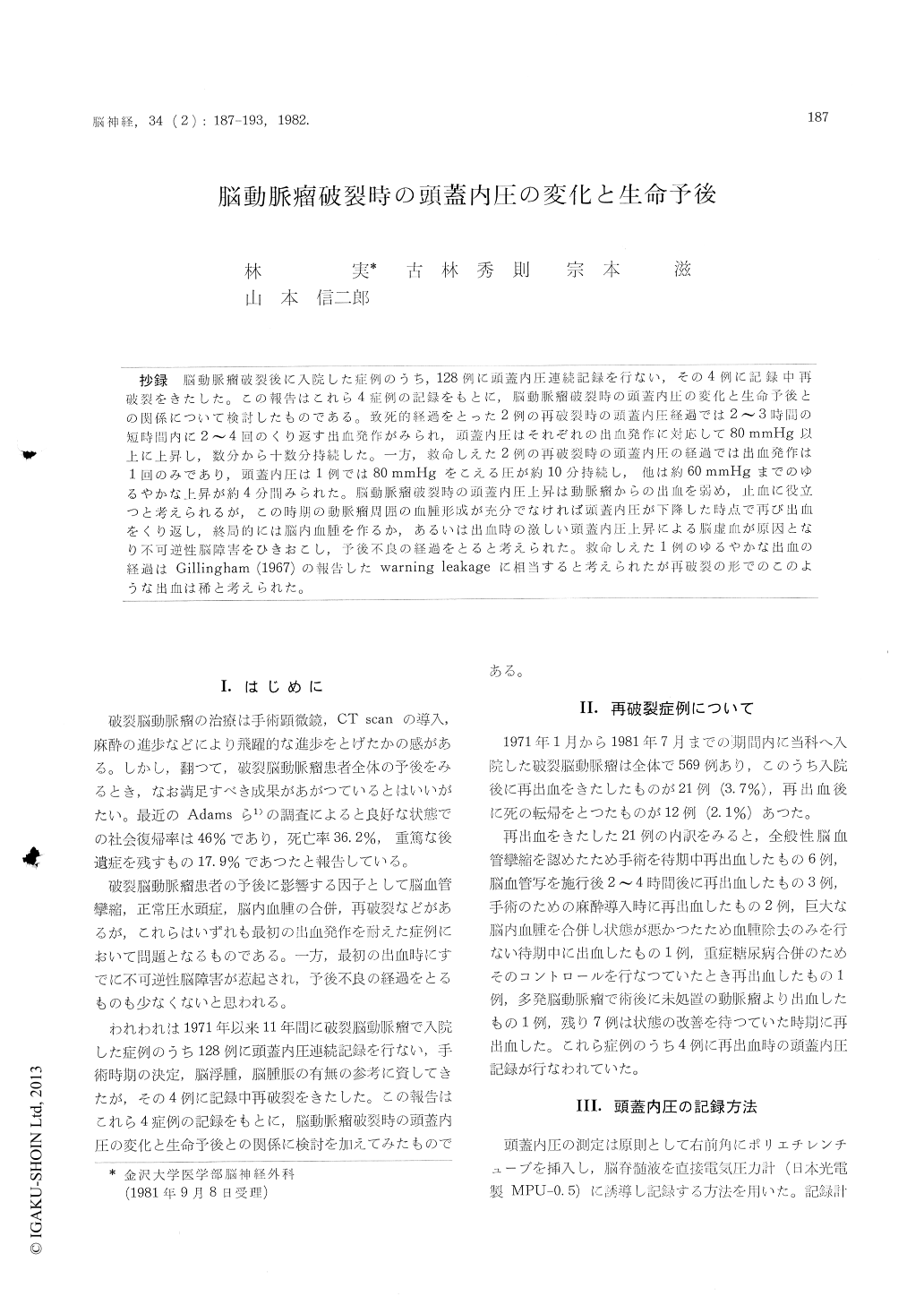Japanese
English
- 有料閲覧
- Abstract 文献概要
- 1ページ目 Look Inside
抄録 脳動脈瘤破裂後に入院した症例のうち,128例に頭蓋内圧連続記録を行ない,その4例に記録中再破裂をきたした。この報告はこれら4症例の記録をもとに,脳動脈瘤破裂時の頭蓋内圧の変化と生命予後との関係について検討したものである。致死的経過をとった2例の再破裂時の頭蓋内圧経過では2〜3時間の短時間内に2〜4回のくり返す出血発作がみられ,頭蓋内圧はそれぞれの出血発作に対応して80mmHg以上に上昇し,数分から十数分持続した。一方,救命しえた2例の再破裂時の頭蓋内圧の経過では出血発作は1回のみであり,頭蓋内圧は1例では80mmHgをこえる圧が約10分持続し,他は約60mmHgまでのゆるやかな上昇が約4分間みられた。脳動脈瘤破裂時の頭蓋内圧上昇は動脈瘤からの出血を弱め,止血に役立つと考えられるが,この時期の動脈瘤周囲の血腫形成が充分でなければ頭蓋内圧が下降した時点で再び出血をくり返し,終局的には脳内血腫を作るか,あるいは出血時の激しい頭蓋内圧上昇による脳虚血が原因となり不可逆性脳障害をひきおこし,予後不良の経過をとると考えられた。救命しえた1例のゆるやかな出血の経過はGillingham (1967)の報告したwarning leakageに相当すると考えられたが再破裂の形でのこのような出血は稀と考えられた。
Intracranial pressure was recorded in 128 patients with subarachnoid hemorrhage due to rupture of the intracranial aneurysm at the Department of Neurosurgery, University of Kanazawa, from January, 1971 to July, 1981. Of these patients, 4had recurrent hemorrhages while awaiting clinical improvement. Two of these patients died of severe hemorrhages while the remaining 2 patients reco-vered. The intracranial pressure recordings are presented and analysed here.
Case 1 A 43-year-old male, suddenly developed a severe headach on November 3, 1971 and lost consciousness a little later. When admitted to our hospital, he was comatose. Carotid angiograms showed a left internal carotid aneurysm. After admission the patient deteriorated to deep coma. Continuous ventricular drainage kept the intra-cranial pressure constant at about 20 to 35 mmHg. Twenty hours after the drainage, the intracranial pressure rose steeply to over 80 mmHg in less than 10 seconds. The patient suddenly became deeply comatose. The intracranial pressure showed high amplitude monotonous waves for about 15 minutes and then fell below the original level. A low flat intracranial pressure pattern was registered suggest-ing the presence of diffuse vasospasm. A second steep intracranial pressure rise was seen 70 minutes after the first, and the patient died.
Case 2 A 49-year-old male was suddenly seized with an extremely severe headache on January 23, 1981. When admitted to our hospital 14 days after the hemorrhage, he was desoriented but showed no neurological deterioration. Carotid angiograms revealed 3 aneurysms on the anterior communicat-ing, left anterior cerebral (A1) and right internal carotid arteries. An operation to repair the an-terior communicating and right internal carotid aneurysms was performed 19 days after the hemor-rhage. Post-operative intracranial pressure was recorded. During the recording, the aneurysm on the left anterior cerebral artery ruptured 4 hours after the operation. Steep rises of intracranial pressure to over 80 mmHg were registered 4 times in the course of 2 hours. Respiratory arrest and fixed pupils were noted at the time of the 4 th rupture, and the patient died.
Case 3 A 49-year-old female experienced a sudden headache accompanied by vomiting on April 15, 1979. When admitted to our hospital 3 days after the hemorrhage, she had no neurological deterioration except for nuchal stiffness. Carotid angiograms showed an aneurysm on the left internal carotid artery. The patient deteriorated to semico-matose 5 days after the hemorrhage due to a diffuse cerebral vasospasm. Intracranial pressure recording was started on the 5th day of the hemorrhage. On the 18th day after the patient had become alert and cooperative, rebleeding occurred. A steep rise of intracranial pressure to over 80 mmHg was seen for about 10 minutes and then fell gradually below the original level. A low flat intracranial pressurepattern as seen in Case 1 was then registered for about 40 minutes. After that a secondary intrac-ranial pressure rise to over 40 mmHg developed. An operation to repair the aneurysm was made 20 hours after the hemorrhage and the patient survived without any neurological deficits.
Case 4 A 46-year-old male suddenly developed a headache accompanied by vomiting on November 6, 1976, and was admitted to our hospital 9 days after the initial symptoms. Carotid angiograms showed a left internal carotid aneurysm with marked widespread vasospasm. An operation was post-poned and intracranial pressure recording was started. On the 10th day after the hemorrhage, intracranial pressure suddenly rose to about 60 mmHg. Subsequently, however, the intracranial pressure fell to the original level and remained there. The patient transiently deteriorated con-comitant with the pressure peak. An operation to repair the aneurysm was performed the next day and a slight amount of fresh blood was observed around the Sylvian fissure. This mild intracranial pressure rise may have been due to minor bleeding as was reported by Gillingham (1967). The patient survived with no neurological deficits.
In the fatal cases, repeated, rapid increases in intracranial pressure in a short time following an intracranial aneurysmal rupture were observed (Case 1 and 2). On the other hand, in the survi-ving cases, intracranial pressure increased only once due to rupture of intracranial aneurysm. We suggest that sudden death following an intracranial aneurysmal rupture may be caused by frequent, repeated bleeding causing intracerebral hematoma and/or severe brain swelling.

Copyright © 1982, Igaku-Shoin Ltd. All rights reserved.


